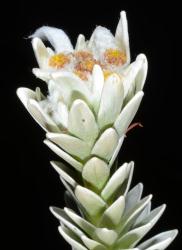- Taxon
- Gallery
- ≡ Helichrysum leontopodium Hook.f., Bot. Antarct. Voy. II. (Fl. Nov.-Zel.) Part I, 141, t. 37B (1853)
- = Gnaphalium colensoi Hook.f., Handb. New Zealand Fl. 154 (1864) – as Gnaphalium (Helichrysum) colensoi
Stock stout, woody; stems much-branched, decumbent, woody at base; branchlets ascending. Lvs sessile, 8–20 × 4–5 mm., 3–5-nerved at base, linear- to lanceolate-oblong, acute to subacute, clad on both surfaces in silvery-white to yellowish, shining, appressed tomentum; basal lvs crowded in subrosettes, cauline densely imbricate to rather distant. Peduncles up to 10 cm. long, clad in appressed foliaceous bracts. Capitula 8–15, congested into dense glomerules up to 25 mm. diam., subtended by up to 20 densely woolly lvs up to 2 cm. long, forming a conspicuous white ray. Phyll. linear-lanceolate, c. 5 mm. long, scarious with basal stiffening, toothed and ciliate towards acute apex, ± woolly on back towards tip. Achenes c. 1 mm. long, pappus-hairs c. 4 mm. long.
[From: Allan (1961) Flora of New Zealand. Volume 1.]
Flowering: Nov.–Mar.; Fruiting: Jan.–Apr.




